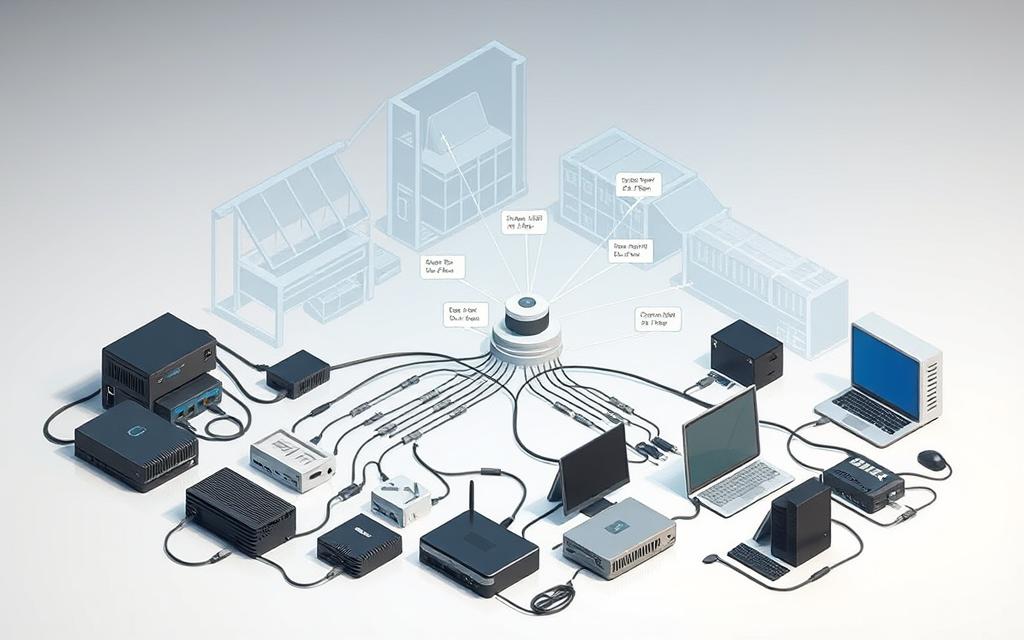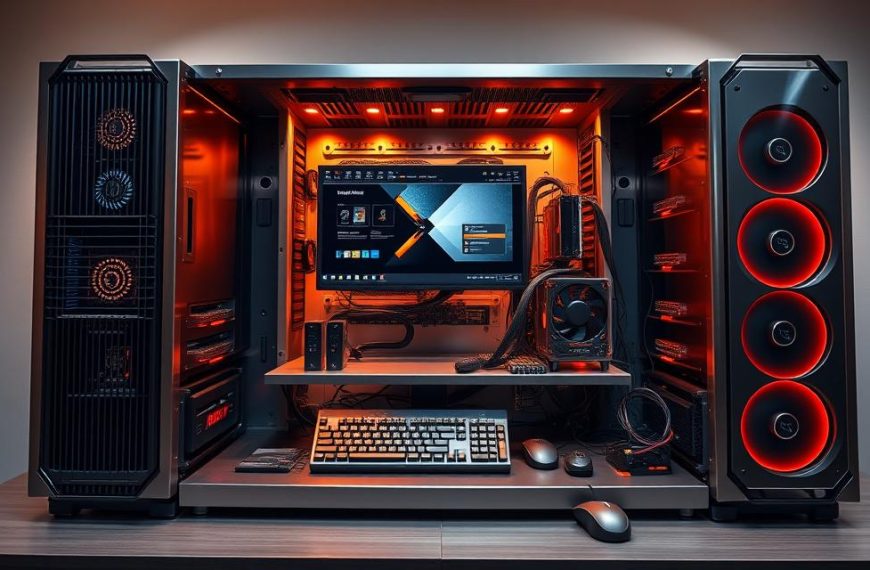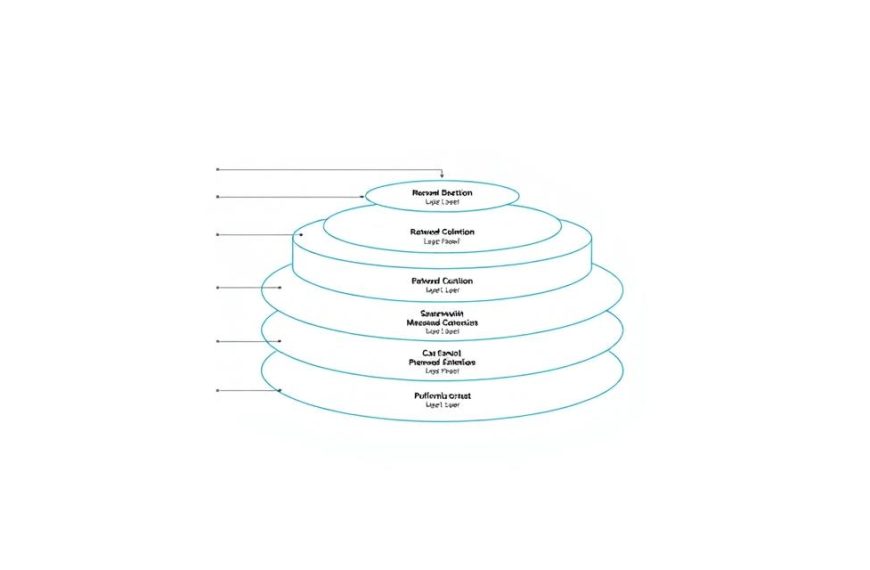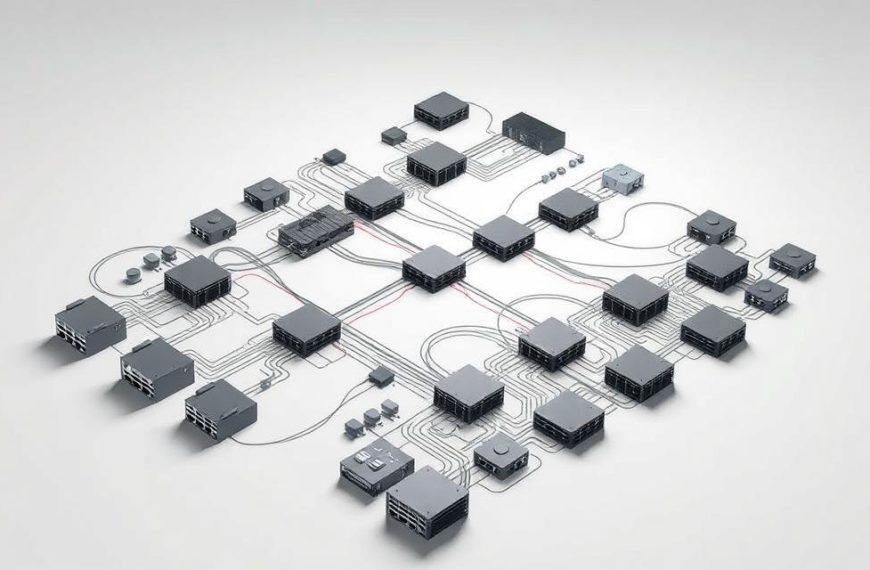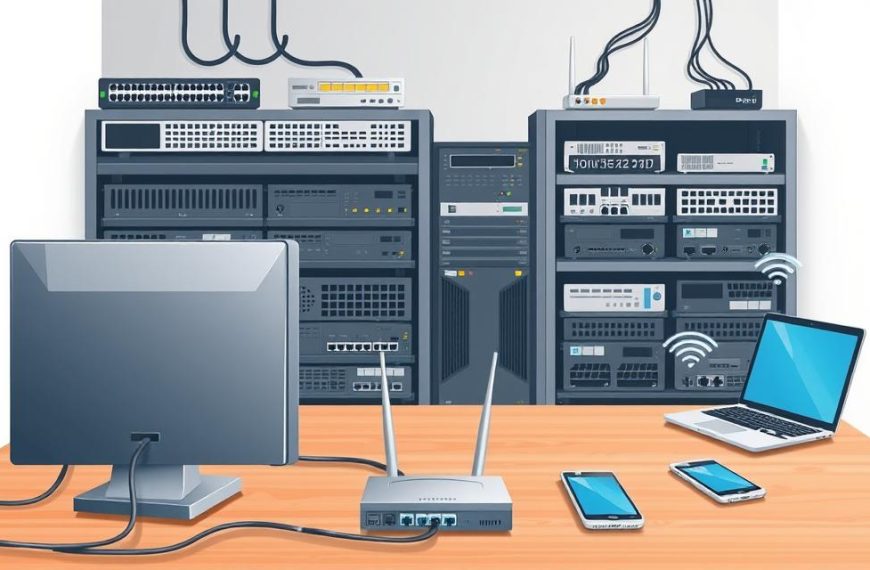Imagine all your office computers, printers, and servers working together smoothly. This is thanks to LAN technology, which makes small network solutions for small spaces.
Local area networks connect devices in small areas like homes, schools, or offices. They help share data and resources among devices.
Unlike wide area networks that cover big areas, LANs focus on small, local spaces. They are built for fast, secure, and reliable local use.
LANs are key for small businesses and schools. They are the heart of today’s digital world. Knowing how they work shows their importance in our connected lives.
What Defines a Local Area Network (LAN)
A Local Area Network connects devices in a small area. It’s different from wide area networks that cover big areas. LANs are found in places like offices, schools, or homes.
Key Characteristics of LANs
LANs have special features that make them stand out. These traits are perfect for local connections.
- Limited geographical coverage – Usually up to 2 kilometres, great for buildings or campuses
- High-speed data transfer – From 100 to 1000 Mbps for quick file sharing
- Multiple connectivity options – Uses wired Ethernet and wireless tech
- Private ownership – Owners control their LAN
- Cost-effective implementation – Cheaper to set up and maintain than big networks
These traits make LANs great for fast data sharing among nearby devices. The right network parts ensure top performance.
Historical Development of LAN Technologies
The history of LANs shows years of tech progress. It started in the 1960s with universities needing internal networks.
Ethernet was a big leap in 1973 at Xerox PARC. It connected computers in a building. This was the start of modern networking.
By 1980, Ethernet was available for businesses. This led to standardised networks. The creation of Ethernet standards made different brands’ gear work together.
In the 1980s and 1990s, LAN tech improved fast. Speeds went from 10 Mbps to 100 Mbps and then to gigabit speeds. Wireless tech also came along, adding flexibility to wired connections.
Today, LANs are the result of all this progress. Modern Ethernet standards keep getting better, meeting the needs of various industries.
Essential Components of a LAN
To build a working local area network, you need both physical and logical parts. These parts are crucial for any LAN, from small offices to big systems.
Hardware Devices: Routers, Switches, and Access Points
The physical setup of a LAN includes key devices. Routers direct traffic between networks, finding the best path for data. They also connect your network to the internet or other networks.
Switches help devices talk to each other within the network. They’re smarter than old hubs, directing data only to the right device. This makes networks more efficient and secure.
Access points let devices connect wirelessly, creating Wi-Fi networks. They support many wireless standards and handle lots of connections at once.
Wired networks often use Category 5 or 6 cables with RJ45 connectors. These cables work well for most LAN speeds and distances. Choosing between Cat5e and Cat6 depends on your needs and future plans.
Software and Protocols: TCP/IP and Ethernet
The software side of LANs is about network protocols. These rules help devices talk to each other and share data well.
TCP/IP is the main protocol for most LANs. It handles addressing, routing, and data sending. IP addresses identify devices, and TCP ensures data is delivered right.
Ethernet is key for wired LANs. It defines how data is structured and sent. Modern Ethernet supports speeds from 10 Mbps to 100 Gbps, meeting different needs.
Older protocols like NetBIOS and IPX/SPX are mostly gone. TCP/IP is now standard, making setup easier and improving how systems work together.
| Protocol | Primary Function | Common Applications | Key Advantages |
|---|---|---|---|
| TCP/IP | End-to-end data delivery | Internet communication, file transfers | Reliability, error correction |
| Ethernet | Local network data framing | Wired LAN connectivity | High speed, low latency |
| Wi-Fi (802.11) | Wireless connectivity | Mobile devices, IoT systems | Mobility, installation flexibility |
| DHCP | Automatic IP assignment | Network configuration | Simplified administration |
Knowing these parts helps network admins set up and keep LANs running well. The right mix of hardware and software ensures networks meet specific needs.
Types of LAN Topologies and Their Applications
Local area networks use different layouts to connect devices. It’s key to know these network topologies for efficient systems. They support smooth data sharing and access to resources.
Star, Bus, and Ring Topologies
The star topology is common in today’s networks. All devices link to a central hub or switch. It has many benefits:
- Easy to fix problems and maintain
- Adding new devices is simple
- One connection failure doesn’t stop others
Bus topology uses one cable for all devices. It’s cheap for small networks but slows down as traffic grows. A problem with the main cable can shut down the network.
Ring topology has devices in a circle, with data moving one way. Each device boosts the signal. It gives equal access but can fail if one device breaks.
| Topology Type | Best Application | Advantages | Limitations |
|---|---|---|---|
| Star | Office networks, schools | Easy maintenance, reliable | Central point failure affects entire network |
| Bus | Small temporary networks | Low cost, simple setup | Performance degrades with more devices |
| Ring | Manufacturing environments | Equal network access | Network failure if one device fails |
Wireless LANs (WLANs) and Wi-Fi Standards
Wireless local area networks (WLANs) have changed how we connect devices. They use radio waves for flexible data sharing and mobility.
The IEEE created the 802.11 standards for Wi-Fi. These standards have grown a lot:
- 802.11b/g worked mainly in the 2.4 GHz band
- 802.11n used new technology for better speeds
- 802.11ac worked in the 5 GHz band for faster speeds
- Wi-Fi 6 (802.11ax) improved efficiency in busy networks
- Wi-Fi 6E used the 6 GHz band for even faster speeds
Today’s wireless networks use three frequency bands: 2.4 GHz, 5 GHz, and 6 GHz. Each band has its own benefits for data sharing and connectivity. The 2.4 GHz band covers more but is slower. The 5 GHz and 6 GHz bands are faster but have less interference.
Wireless network topologies are great for homes and small businesses. They’re easy to set up and change as needed. Without cables, you can easily move devices around.
Setting Up a Small Physical Area Network
Creating a local area network needs careful planning before you start. You must think about your needs and the environment. This ensures your system works well and reliably.
Planning and Design Considerations
Start by looking at the space and how you’ll use it. Think about how many devices will connect at once and how much bandwidth they need. This helps you choose the right hardware and cables.
Consider all devices, including future ones. Pick a network switch with enough ports for growth. For small network solutions, an 8-24 port switch is usually enough.
Choosing the right cables is key for network performance and life. Different category cables have different speeds and prices. It’s important to pick the right one for now and the future.
| Cable Category | Maximum Speed | Recommended Use | Maximum Distance |
|---|---|---|---|
| Cat 5e | 1 Gbit/s | Basic office networks | 100 metres |
| Cat 6 | 10 Gbit/s | High-speed applications | 55 metres |
| Cat 6a | 10 Gbit/s | Data centres | 100 metres |
| Cat 7 | 10 Gbit/s | Future-proof installations | 100 metres |
Choosing a topology depends on your needs and budget. Star topologies are best for reliability, while bus topologies are good for very small, low-budget setups.
Implementation Best Practices
When installing, manage cables well and avoid electrical interference. Use cable trays or conduits and label cables clearly for easy troubleshooting later.
Start with your router’s setup. Enable DHCP to automatically assign IP addresses. Most routers do this by default, making it easier for small network solutions.
Good network setup is about more than just connecting devices. It’s about creating a secure and efficient system that supports your business goals.
Follow the manufacturer’s instructions to set up your network switch. Make sure it supports your chosen speeds. For mixed environments, choose switches that can auto-negotiate speeds.
Test your network thoroughly. Use ping tests to check connections and speed tests to confirm bandwidth. Keep records of all settings and configurations.
Start with basic network security steps like changing passwords and enabling firewalls. These steps help secure your network before adding more advanced features.
Begin monitoring your network from the start. Regular checks help spot issues early, keeping your network running smoothly.
Security Measures for LAN Protection
It’s vital to have strong security for local area networks to fight off new threats. Good protection plans mix technical steps and rules to guard against many dangers.
Firewalls and Encryption Techniques
Firewalls are key in keeping networks safe. They check all traffic coming in and out. They block unwanted access and let in safe messages.
Hardware firewalls guard whole networks. Software firewalls add extra safety to devices in the LAN.
Encryption is also crucial for LAN safety. Wireless networks use WPA2 and WPA3 to keep data safe.
These methods make data unreadable to others. Only those with the right keys can see the real information.
Access Control and Monitoring
Good access control means only the right people can use the network. There are many ways to check who’s who, from simple passwords to more complex methods.
Virtual LANs (VLANs) help keep networks safe by dividing them into parts. This stops problems from spreading too far.
Tools that watch for threats all the time are very helpful. They spot odd behaviour and warn admins before it’s too late.
Having clear rules for how to use the network and keep it safe is important. Regular checks and updates keep the network safe from new dangers.
| Security Measure | Primary Function | Implementation Level | Effectiveness Rating |
|---|---|---|---|
| Hardware Firewall | Network perimeter protection | Enterprise | High |
| WPA3 Encryption | Wireless data protection | All wireless networks | Excellent |
| Multi-factor Authentication | User identity verification | System access points | Very High |
| Network Monitoring | Threat detection | Continuous operation | High |
| VLAN Segmentation | Traffic isolation | Network architecture | Medium-High |
Setting up these security steps needs careful planning and upkeep. Companies must find the right balance between safety and keeping things running smoothly.
New tech keeps improving LAN protection. Keeping up with these changes helps keep networks safe and strong.
Advantages of Utilising a LAN
Setting up a local area network (LAN) brings many benefits. It makes work more efficient and productive. LANs are key for businesses and schools in small spaces.
Enhanced Collaboration and Data Sharing
LAN technology changes how teams work together. It makes data sharing easy between devices. This means no more waiting for files or emails.
Sharing expensive equipment is another big plus. Many can use things like printers and scanners. This saves money and makes sure everyone has what they need.
Working together in real-time is easy with LANs. Teams can work on projects together without any problems. This helps them be more creative and finish projects faster.
LANs also make managing data easier. One person can keep everything safe and secure. This keeps data safe and reduces the chance of losing important information.
Cost-Effectiveness and Scalability
Setting up a LAN can save a lot of money. The cost of network components is worth it for all the shared resources. It means less need for individual equipment.
Keeping a LAN running is also cheap. Problems can be fixed from one place. This means less time wasted and fewer interruptions.
LANs are great because they can grow with your business. Adding new devices and users is easy. This helps your business grow without spending too much.
LANs also help you communicate faster. This means your team can work better and finish projects quicker. This helps your business make more money and stay ahead of the competition.
| Advantage Category | Specific Benefits | Impact on Organisation | Implementation Considerations |
|---|---|---|---|
| Collaboration Enhancement | Real-time file sharing, resource pooling | Improved team productivity | Bandwidth requirements, access permissions |
| Cost Reduction | Shared internet connection, peripheral sharing | Lower operational expenses | Quality of service configurations |
| Scalability Options | Easy expansion, modular growth | Future-proof investment | Infrastructure planning, cable management |
| Security Management | Centralised control, uniform protocols | Reduced risk exposure | Firewall configuration, access policies |
Using LANs makes work better and saves money. They are key for modern businesses. With good planning, LANs keep bringing benefits as your business grows.
Common Challenges and Troubleshooting
Even the best local area networks can face problems that need careful fixing. These issues might be when devices can’t connect or when the network slows down. To solve these, we need to use special methods to get the network working right again.
Addressing Connectivity Problems
Connectivity issues are often the biggest headaches in LANs. They can come from damaged cables, loose connections, or faulty cards. Wireless networks also struggle with interference from other devices and physical barriers.
Another big problem is when settings are wrong. IP address clashes happen when devices use the same address. Wrong subnet masks stop networks from talking to each other. Devices not being recognised can point to driver or hardware issues.
To start fixing network troubleshooting, check the physical connections first. Then, look at the software settings. Finding the exact problem helps fix it, whether it’s one device or the whole network.
Managing Network Congestion
Network congestion happens when too much data tries to go through at once. This slows things down and makes it harder to get work done.
Using Quality of Service (QoS) settings helps manage who gets priority. This means important stuff like video calls gets through first, even when it’s busy.
When congestion keeps coming back, it might be time to upgrade. Adding more switches or increasing internet speed can help. Knowing the latest Ethernet standards is key when updating your network.
For ongoing problems, knowing the common network issues helps solve them. Keeping an eye on your network can spot problems early. This way, you can fix things before they get worse.
Conclusion
Local area networks have changed a lot. They are now key in our daily lives. They support everything from old computers to smart home gadgets. This shows how important it is to know about local area networks.
Knowing how LANs work helps us make better choices. It’s about designing and managing networks well. It’s also about keeping data safe and solving network problems.
LAN technology keeps getting better. It’s now linked with IoT devices and new security needs. Companies that understand LANs can keep up with these changes. This knowledge is essential for creating strong and flexible networks.
